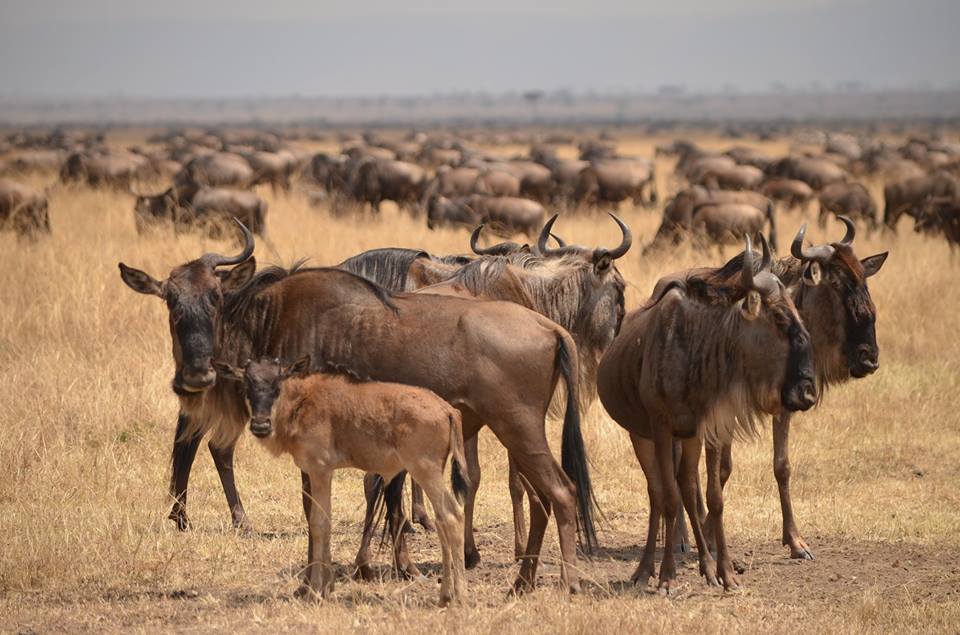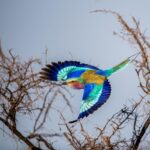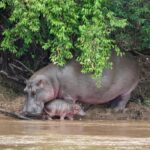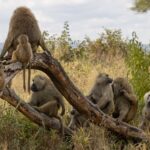
What is Unique About the Wildebeest Migration Between Serengeti and Masai Mara?
The Great Wildebeest Migration is a truly remarkable natural phenomenon, often hailed as one of the “Seven Natural Wonders of the World.” This annual spectacle involves the mass movement of over 1.5 million wildebeest, along with hundreds of thousands of zebras, gazelles, and other animals, across the Serengeti-Mara ecosystem of Tanzania and Kenya. What makes this migration so unique isn’t just the sheer number of animals involved, but also the complex interplay of factors that drive it, the challenges the animals face, and the profound impact it has on the ecosystem.
The Driving Forces Behind the wildebeest Migration
The primary driver of the Great Migration is the search for food and water. The wildebeest, being grazers, are constantly seeking out areas with fresh, nutritious grasses. The availability of these resources is heavily influenced by rainfall patterns, making the migration a dynamic and unpredictable event. The animals follow the rains, moving in a generally clockwise direction across the Serengeti and into the Masai Mara.
The Serengeti plains in Tanzania, particularly the southern region, are the site of the calving season, typically from January to March. During this time, the short, mineral-rich grasses provide the ideal conditions for the wildebeest to give birth and raise their young. This area, formed by volcanic activity, produces grasses that are highly nutritious during the rainy season but dry up quickly.
As the dry season approaches, the herds begin their northward journey, seeking out greener pastures. This movement takes them through the central Serengeti, the Western Corridor, and eventually into the Masai Mara National Reserve in Kenya. The timing of this movement varies each year, depending on the onset and duration of the rains.
The Challenges of the Journey
The Great wildebeest Migration is not without its perils. The animals face numerous challenges throughout their journey, including:
- Predation: The migration attracts a host of predators, including lions, leopards, cheetahs, hyenas, and wild dogs. These predators prey on the vulnerable young calves and the weaker members of the herd, making the migration a constant struggle for survival.
- River Crossings: The Mara River, which flows through the Serengeti and Masai Mara, presents a significant obstacle. The river is home to large Nile crocodiles, which lie in wait for the migrating animals. The river crossings are often chaotic and dangerous, with many wildebeest and other animals succumbing to drowning or predation.
- Exhaustion and Starvation: The long distances covered during the migration, coupled with the scarcity of food and water in certain areas, can lead to exhaustion and starvation, especially for the young and the old.
- Drowning: The sheer volume of animals attempting to cross the rivers can lead to drowning, as the animals are crushed by the sheer volume of panicking wildebeest trying to scramble up the equally steep banks on the other side.
The Uniqueness of the Serengeti-Mara Ecosystem
The Serengeti-Mara ecosystem is unique in several ways, contributing to the spectacular nature of the Great Migration:
- Vastness and Biodiversity: The ecosystem is vast, covering thousands of square kilometers, and supports an incredible diversity of wildlife. This includes not only the wildebeest and other migrating species but also a wide range of predators, herbivores, and birds.
- Unpredictability: The migration is driven by rainfall, making it an unpredictable event. The timing and location of the herds can vary from year to year, adding to the excitement and allure of the spectacle.
- Dramatic River Crossings: The Mara River crossings are a highlight of the migration, offering a dramatic display of nature’s power and the struggle for survival. These crossings are a major draw for tourists and wildlife enthusiasts.
- Ecological Significance: The migration plays a crucial role in maintaining the health of the ecosystem. The grazing and trampling of the wildebeest help to stimulate grass growth, while their waste fertilizes the soil. The migration also provides a food source for predators, supporting their populations.
Key Differences Between Serengeti and Masai Mara
While the migration is a continuous event, there are some key differences between the Serengeti and the Masai Mara:
- Calving Season: The calving season, when the majority of wildebeest calves are born, takes place in the southern Serengeti. This is a critical period for the herds, as the young calves are particularly vulnerable to predators.
- River Crossings: The most dramatic river crossings occur in the Mara River, which flows through both the Serengeti and the Masai Mara. These crossings are a major highlight of the migration, attracting large numbers of tourists.
- Grazing and Resting: The Masai Mara offers lush green grasslands and abundant water sources, making it an ideal location for the herbivores to replenish their energy reserves before the cycle repeats itself.
- Predator Density: The Masai Mara is known for its high density of predators, including lions, leopards, and cheetahs, which are drawn to the large concentrations of migrating animals.
The Impact of Climate Change
Climate change poses a significant threat to the Great wildebeest Migration. Changes in rainfall patterns, increased temperatures, and more frequent extreme weather events can disrupt the migration routes, reduce the availability of food and water, and increase the risk of mortality for the animals. This can lead to a shortening of the stay in the Masai Mara plain or eliminating it altogether.
Best Safari Itinerary to See Wildebeest Migration Between Serengeti and Masai Mara:
The Great Migration is a year-round event, but the best time to see it is during the dry season, from July to October, when the dramatic Mara River crossings take place. The migration’s route is a clockwise loop, with the herds moving from the Serengeti in Tanzania to the Masai Mara in Kenya and back again.
The following is a step-by-step breakdown of a recommended itinerary:
- Planning and Booking:
- Book Early: Lodges and camps fill up quickly, especially during the peak season (June to October) for the river crossings. Plan at least a year in advance.
- Choose a Reputable Operator: Opt for a local tour operator for a comprehensive and hassle-free safari experience. Check online reviews and pay attention to negative feedback.
- Itinerary Overview:
- Duration: A 7-12 day safari is recommended to fully experience the migration.
- Starting Point: The safari typically starts in Nairobi, Kenya, or Arusha, Tanzania.
- Destinations: The itinerary should include both the Masai Mara National Reserve in Kenya and the Serengeti National Park (including the Ndutu area) in Tanzania.
- Month-by-Month Breakdown (Example Itinerary):
- December – March: Calving Season (Ndutu Plains, Southern Serengeti): Witness the calving season in the Ndutu and Salei Plains, where up to 8,000 wildebeest calves are born daily. This period offers excellent predator activity.
- April – May: Serengeti (Central Serengeti): The herds move north, and the breeding season begins.
- June: Grumeti River Crossing (Western Serengeti): The herds begin crossing the Grumeti River.
- July – October: Mara River Crossing and Masai Mara: The herds reach the Mara River, and the dramatic crossings begin. This is the peak season in the Masai Mara.
- October – November: Return to Serengeti: The herds begin to move south again, returning to the Serengeti.
- Detailed Daily wildebeest migration Itinerary (Example – 8 Days):
- Day 1-2: Masai Mara (Kenya): Arrive in Nairobi, transfer to Masai Mara. Full-day game drives in the Mara Triangle, focusing on the migration and the Big Five.
- Day 3-4: Masai Mara (Kenya): Full-day game drives, including the Mara River crossing (if the timing is right). Explore the reserve and its conservancies.
- Day 5: Serengeti (Tanzania): Transfer from Masai Mara to Serengeti (via border crossing). En-route game drive to the lodge.
- Day 6: Serengeti (Tanzania): Full-day game drive in the central Serengeti, following the migration.
- Day 7: Ngorongoro Crater (Tanzania): Transfer to Ngorongoro Crater. Descend into the crater for a game drive.
- Day 8: Departure: Transfer to Arusha or Kilimanjaro International Airport (JRO) for departure.
- Accommodation:
- Migration Camps: These temporary camps move with the migration, offering a close-to-nature experience.
- Semi-Permanent Tented Camps: Offer a balance of comfort and immersion in the wilderness.
- Lodges: Provide more permanent facilities and amenities.
- Activities:
- Game Drives: Essential for viewing the migration and other wildlife.
- Hot Air Balloon Safaris: Offer a unique perspective of the vast herds.
- Walking Safaris: Provide a closer look at the ecosystem.
- Cultural Visits: Experience local Maasai culture.
- Considerations:
- Crowds: The Masai Mara can get crowded during peak season. Consider private conservancies for a more exclusive experience.
- Flexibility: The migration is unpredictable. A longer safari increases the chances of witnessing river crossings.
- Budget: Costs vary depending on accommodation and activities. Private safaris are generally more expensive than group safaris.
The best safari itinerary to see the wildebeest migration between the Serengeti and Masai Mara is a well-planned trip that includes both parks, with a focus on the timing of the migration and the river crossings, and a duration of at least 7-12 days.
Conclusion
The Great Wildebeest Migration between the Serengeti and Masai Mara is a truly unique and awe-inspiring event. The combination of the vast scale of the migration, the challenges faced by the animals, the dramatic river crossings, and the ecological significance of the ecosystem makes it one of the most remarkable wildlife spectacles on Earth. The migration is a testament to the resilience of nature and the intricate connections between different species and their environment. It is a reminder of the importance of conservation efforts to protect this incredible natural wonder for future generations.
Leave a comment:
You must be logged in to post a comment.




Comment 01
Unique experiences that differentiate Kenya from other safari destinations - Astute Africa Safaris,
08 August, 2025[…] The Great Migration is arguably Kenya’s most famous natural spectacle, a phenomenon shared only with Tanzania. Each year, over two million wildebeest, zebras, and gazelles traverse from Tanzania’s Serengeti into Kenya’s Maasai Mara in search of fresh grazing grounds. Witnessing the dramatic Mara River crossings, where predators lie in wait, is a highlight that draws visitors from around the globe. This unique experiences that differentiate Kenya from other safari destinations, an event that is a powerful demonstration of nature’s raw power and is a primary reason many choose Kenya for their safari. […]